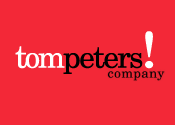Yes, but…how can mundane work be WOW!?
Who Thinks that the Work Matters?
Execution, the all-important “LAST 99 PERCENT” according to Tom Peters, is rarely given such high priority in practice. In our experience, it is the people who do the planning and strategizing who usually grab the management attention while the people who deliver the products and services often feel second class.
Excellence requires a combination of systems and passion, right? Yet, when our system routinely throws other people’s plans “over the wall” for execution, we wonder why the doers often show a lack of passion for their work.
So, can people be expected to be passionate about the nitty-gritty business of getting routine work done? “Most certainly” says Valarie Willis, Tom Peters Company’s leadership, innovation and project management virtuoso. We asked Valarie to give us some tips on how to make this happen.
Tactic One: Closing the Big Disconnect
People will naturally feel their work is mundane if they don’t see value in it and it doesn’t connect in their minds to a vision of the future that they aspire to and share. When people do not feel part of the bigger picture at work, which is common, there is a big disconnect to be overcome. And that affects the whole process, from planning to delivery.
So, when you are planning a project at work, take Steven Covey’s advice and “start with the end in mind.” Think about the people whose help is needed to resource and support the project, where could the project be piloted, who are the likely mainstream implementers, who will be the main customers of the project? etc? etc? Then think, what do I have to do so that all these people can become as passionate about this project’s success as I am?
Invite your implementers into the project discussions earlier rather than later. Allow them to make their input. Allow them to see for themselves how their part in fulfilling this project connects to their big picture.
Case Study: Help the Dots to Connect
A client of mine who worked in a marketing department was tasked with building trust and improving communication across multiple remote facilities. She knew from the outset that a “top down” solution—no matter how brilliant—would not work and that local buy-in was essential.
Her approach was to invite some people from each location to get together to talk about why and how communications and trust could be improved. These people were invited to become ambassadors at each location for the coming year. They discussed what changes would have to be made, and shared what these changes would mean for their home departments and for the organization as a whole.
The team came up with many novel and effective ideas to improve communications. An example? On the same day, at the same time, in each location, the ambassadors hosted communication sessions, featuring their local talent, using video shot in the field, and of course, serving food. Over their year as ambassadors, they incorporated a variety of fun activities and this approach got people around the business connected in ways that would have been impossible before.
The real key to success was that these sessions always happened as scheduled, were always one hour long and always ended on time. Honoring the commitment showed cross-location communication was important. Ownership and trust built up steadily through the year. When the first year was up, a serious team celebration was held including new members who had volunteered to take over as ambassadors for year two.
Tactic Two: Owning the Execution
Projects are fertile arenas in which human beings can be creative and flourish at work. Encourage and help your people to see their routine assignments as a series of projects, NOT a never-ending conveyor belt of mundane tasks. Each piece of work needs to have a specific goal, a timeline and a predefined outcome for a ‘customer’. Projectizing work, as we call it, helps people to take ownership, and by reframing their projects, i.e., setting themselves new goals, timing and outcomes, sets up the opportunity for people to enrich their work by adding small causes they do care about.
Case Study: Taking Ownership of your Project
A recent delegate at one of our WOW! Projects Labs, a HR manager from a leading UK retailer employing many part time and casual workers, was struggling to meet her store’s absence and lateness improvement targets. When we introduced the idea of projectizing, she was keen to convert this soul-destroying daily grind for her people into work they could get excited about. Her solution was to convert it into ‘the great place to work’ project. Instead of struggling to control errant employees’ behavior, she reframed the store environment and culture as the problem. This gave her HR team a completely new agenda, and in turn, gave her line managers the chance to engage with their people in some new and very different activities.
Why not try these ideas for yourself the next time you are assigned a soul-destroying job. Projectize it, decide who the customer is, what a good outcome would be for them, and set a target completion date. Then reframe and convert it by adding something you do care about and have passion for completing.
An extract from this article appeared in the latest TP Times. Sign up if you’d like to receive future editions.

